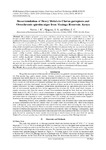Bioaccumulation of Heavy Metals in Clarias gariepinus and Oreochromis spirulus niger from Masinga Reservoir, Kenya

View/
Date
2014-10Author
Nzeve, Julius K.
Njuguna, S. G.
Kitur, E. C.
Metadata
Show full item recordAbstract
The pollution of aquatic ecosystems with heavy metals has become a worldwide concern. This is
because of their ability to bioaccumulate in aquatic organisms and especially in fish which is a source of
livelihood for human populations. Therefore, an assessment of heavy metal contamination (Cu, Zn, Pb, Cr and
Mn) in two selected food fish species, Clarias gariepinus and Oreochromis spirulus niger in Masinga reservoir
was carried out between January 2013 and December 2013. Heavy metal Concentrations were determined
using atomic absorption spectrophotometer. The data obtained was analyzed using one way analysis of variance
and significant differences accepted at p ≤ 0.05. Post Hoc Turkeys’ test was used to separate means. In Clarias
gariepinus, mean metal concentrations (mg/kg) in muscles were Cu (0.677 – 0.974), Zn (32.929 – 37.205), Pb
(0.643 – 1.078), Cr (0.516 – 0.858) and Mn (0.452 – 0.990). Pb exhibited a significance difference between the
sites (p < 0.05). Mean values for heavy metals in Oreochromis spirulus niger (mg/kg) for different sites were Cu
(0.515 – 0.782), Zn (29.645 – 37.999), Pb (0.552 – 0.765), Cr (0.559 – 0.791) and Mn (0.183 – 1.480). Only Mn
showed significant differences between the sites (p < 0.05). Heavy metal concentrations in the two fish species
were lower than World Health Organization (WHO) set limit except for Cr. Results from this study demonstrate
the need for an ecosystem approach towards sustainable management of reservoirs. This will curb aquatic
pollution which is a health risk for people consuming aquatic resources contaminated with heavy metals
